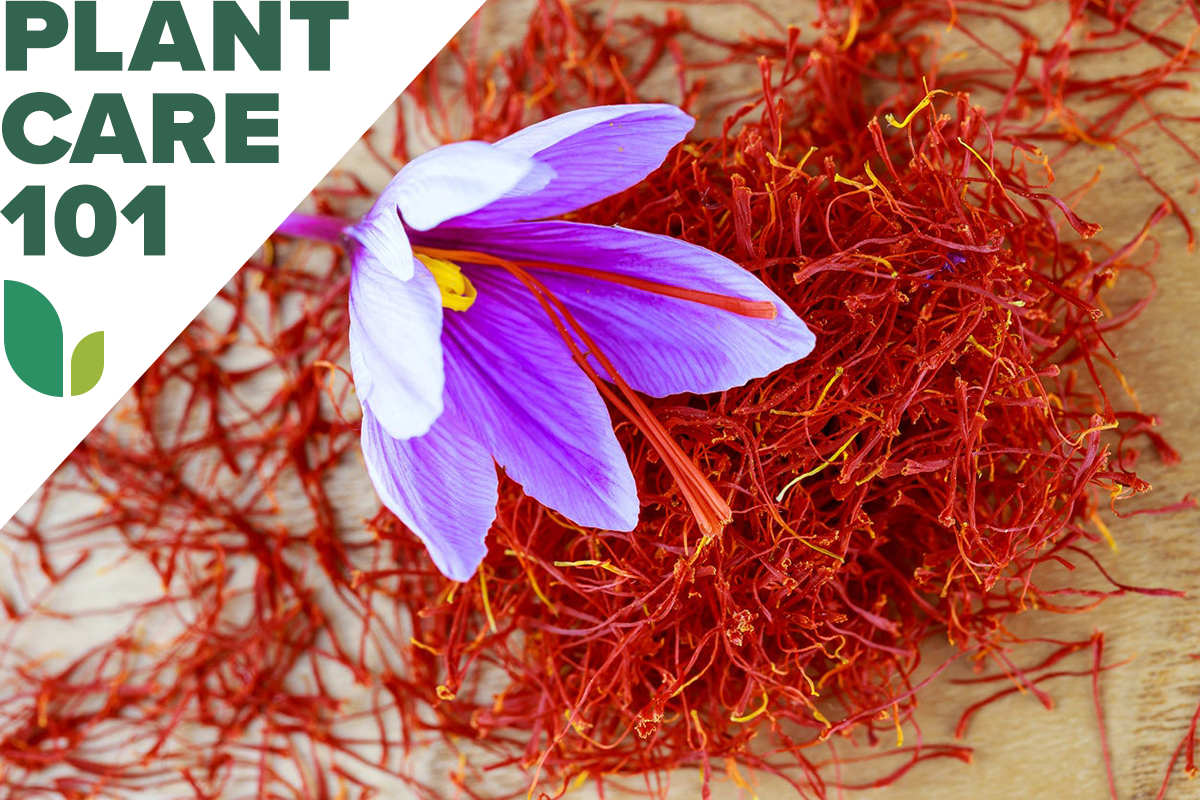

We may earn revenue from the products available on this page and participate in affiliate programs. Learn More ›
If you find yourself reaching for saffron in your spice rack, you’re not alone. This delicate, coveted spice is prized for its complexity of flavor: It’s both sweet and floral while also tasting earthy and mild. Saffron imposes a beautiful yellow color in rice and dishes like paella, among others, when used in cooking.
Although it has been harvested and traded since ancient times, saffron is unfortunately among the most expensive spices in the world. The good news is that this highly desirable spice comes from a beautiful purple flowering plant. The even better news? It’s relatively easy to add to your home garden once you learn how to grow saffron by following a few simple guidelines.
Growing Saffron at a Glance
Common Name: Saffron, Saffron crocus
Scientific Name: Crocus sativus
Hardiness Zone: 5 to 8
Soil: Well draining, pH 6 to 7
Light: Full sun to partial shade
Water: Regular, avoid overwatering
Food: Once a year
Propagation: Corms, division
Safety: Edible stigmas, spice
Saffron Plant Characteristics
A low-growing purple-flowering plant, the saffron crocus—and its harvestable bright-red center stigma—is as striking as it sounds. Saffron crocus is grown from corms, which are solid underground stems that store the plant’s food during its dormant period, not unlike bulbs. In fact, many growers sell “crocus bulbs,” though technically, they are corms. Each corm produces long, dark-green, grasslike leaves in the spring. These leaves provide energy for the plant and then die back in summer.
In the fall, each plant will produce several beautiful flowers, which typically peek out of the ground in September. Each flower has six lilac-colored petals, sometimes streaked with a pale purple or white. Each flower contains three contrasting yellow stamens (the male part of the plant that produces pollen) and three distinctive red-orange stigmas (the female part of the plant). It is these stigmas that produce the spice saffron.
Saffron is traditionally used as an edible spice, but it also can serve as a natural fabric dye, producing a deep shade of yellow. The use of saffron as a dye has grown out of fashion owing to the long and somewhat labor-intensive process of harvesting the spice. Machine harvesting does not work on this plant; it must be gathered delicately by hand, often using a pair of tweezers. For the home gardener used to harvesting with their own two hands, learning how to grow saffron can be a pleasure and a delight at harvest time.
RELATED: 13 Unusual Ways to Use What’s in Your Spice Rack
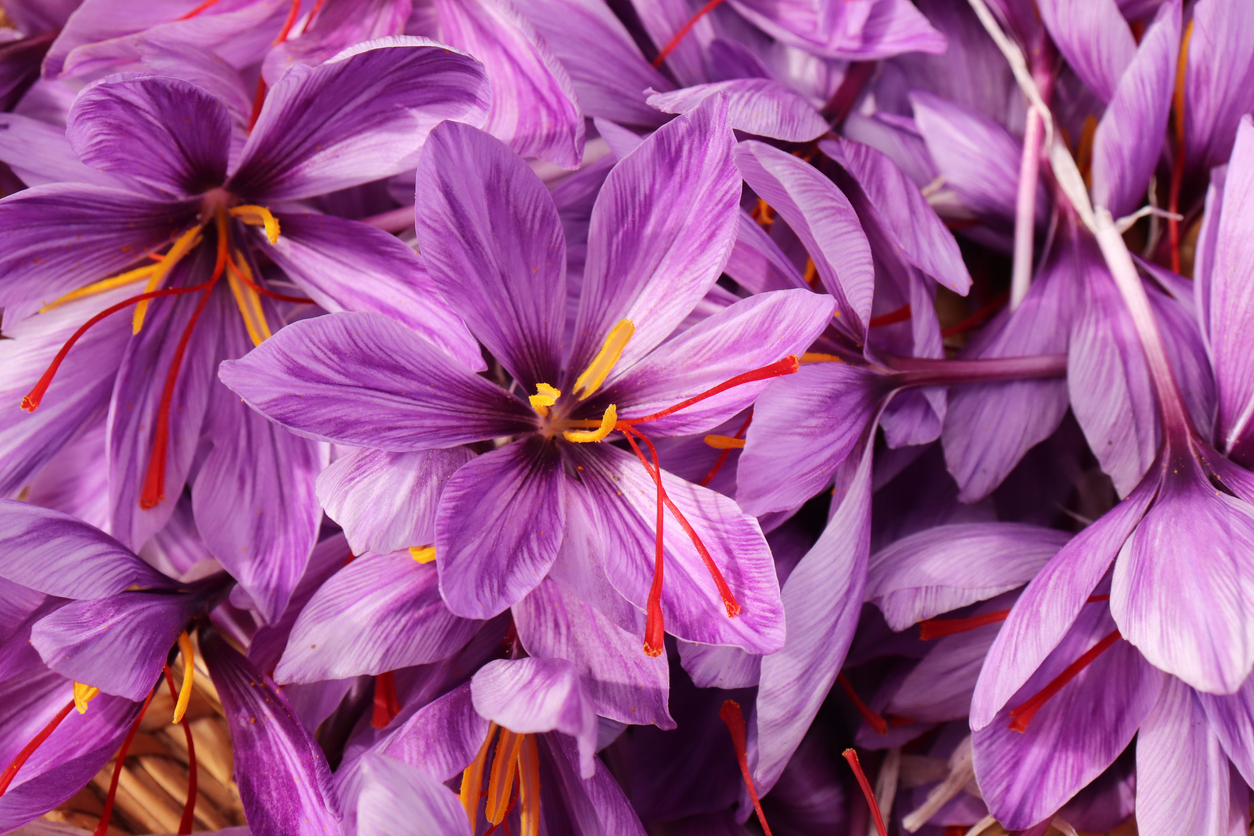
Recommended Saffron Varieties
Only one plant produces the true spice saffron: Crocus sativus. Though this is the most commonly accepted scientific name, saffron also sells under previously used names of Crocus autumnalis, Crocus officinalis, and Crocus sativus var. officinalis. Some growers may offer crocus corms (or bulbs) for sale in different sizes. A larger corm does not indicate a larger flower size but rather the ability to grow more flowers faster, since the large corms can store more energy.
Planting Saffron
Saffron is a rewarding and beautiful plant in the garden. Every year, the corms multiply, eventually growing enough to divide. Although it reportedly takes hundreds of thousands of flowers to produce a pound of saffron, the plant’s ability to multiply gives the home gardener more saffron to harvest. Because of this, growing saffron for profit is something a home gardener can do, but it will take a few years. It takes the stigmas from about a dozen flowers to season the average dish.
When is the best time to plant saffron?
Plant saffron corms 2 inches deep about 6 weeks before the first expected fall frost, usually mid-August to September. Keep in mind that the plants often won’t produce flowers in the first season, though they will produce leaves in the spring. These grasslike leaves will die back, with flowers appearing the following autumn. Each year, as corms grow, the plants produce more flowers.
Overall, saffron corms don’t store very well, so they should be planted shortly after you purchase them. In saffron growing zones 5 to 8, the plants can stay in the ground through winter since they are hardy to -15 degrees Fahrenheit.
Where can saffron grow?
Saffron growing conditions are not hard to achieve. Plant the low-growing saffron crocus as a border plant, along garden paths, or even between stepping stones. Because it grows to a height of only 4 to 6 inches, the plant can get lost in beds with taller flowers, so plant it en masse and keep the crocus along the edges of bigger beds. Saffron crocus requires well-draining soil and does well in rock gardens. The plant prefers full sun but should be planted in an area with partial shade in hotter climates.
The best climate to grow saffron exists in USDA zones 5 to 8. In areas with winters colder than USDA Zone 5, gardeners will need to lift the corms from the soil and overwinter them in containers. Dig them up, place them in pots, and cover them with sand or peat moss. Alternatively, plant saffron in containers that can be brought indoors in the winter.
Growing saffron indoors is possible by forcing bulbs in the winter, much like narcissus, though this method does not guarantee flowers year after year. To force a corm, simply plant it in a shallow tray with pebbles or place it in a special vase for forcing bulbs (one that allows the bottom of the bulb to rest just above the water). Harvest the stigmas once the plants begin to bloom.
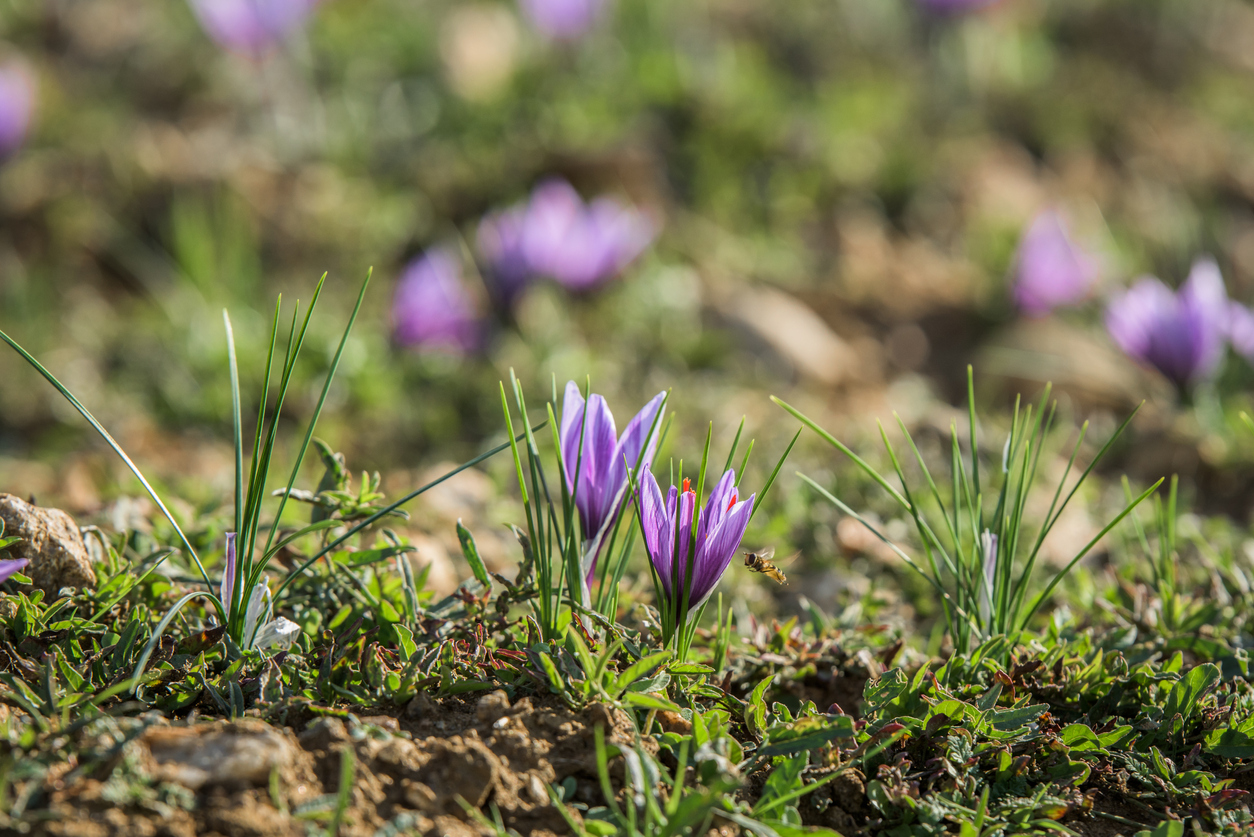
How do you plant saffron?
Like other bulb-type plants, saffron is fairly simple to plant. There are two critical components: depth and spacing.
- Prep the soil by enriching it with organic compost or mulch. Be sure the soil is loose and well draining before planting.
- Use a garden trowel or your hands to dig a hole 2 to 3 inches deep.
- If pests like mice, gophers, and voles are a problem, line the planting area with wire mesh or planting cloth.
- Plant the corm of the saffron plant root side down (the wider side of the corm). Make sure the pointier part faces up.
- Stagger the corms 4 to 6 inches apart. They can be planted closer together if necessary, but avoid planting them in a straight row. The low-profile flowers will have a bigger impact when they appear in clusters.
- Cover with soil.
- Water.
- If squirrels are an issue, try covering the area of planting with a rock resembling pea gravel that commonly is called “turkey grit.” This makes it unpleasant for tiny paws to dig.
- Continue to water the saffron crocus at least once a week throughout the fall. Avoid overwatering because they will rot in soil that is too moist. Check the soil to be sure it is not waterlogged or too dry. Increase or decrease watering as necessary.
Can you grow saffron in containers?
Yes, growing saffron in containers is a great way to keep saffron on a porch or deck, and it makes it easy to overwinter the plants indoors if being grown in a climate that has harsher winters (below Zone 5). Be sure the container has adequate drainage and isn’t too deep. A shallow wide container will work best. Follow the instructions for planting in the ground, but bear in mind that a container will dry out faster, so you might need to increase watering after planting and during the blooming period.
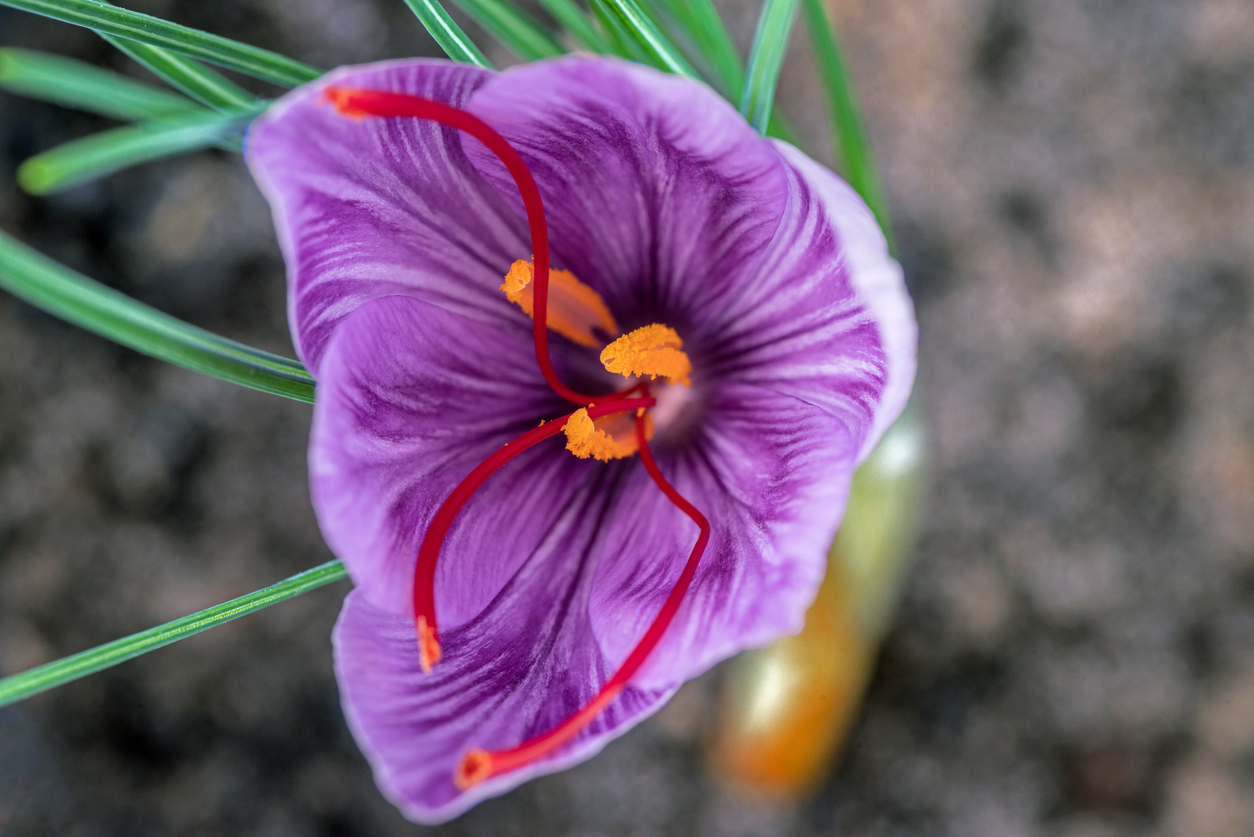
Watering Saffron Plants
Overwatering is more damaging to saffron than underwatering. Growing saffron crocus requires regular water during its growth and blooming periods, but the timing will be different depending on the climate. Areas with a warm, dry spring will require more water than a climate with rainy spring weather. Check the soil by pressing fingers into the dirt around the corms; if it’s bone-dry, water. If it’s soggy, decrease the amount of water.
Fertilizing Saffron
Saffron is not a fussy plant. When it comes to fertilizing, most regular garden fertilizers will do. When planting saffron, be sure the soil is amended with nutrients to help feed the corms as they grow. This can include a slow-release granular fertilizer. Apart from that, fertilizing once a year in the spring when the leaves come up is usually sufficient. Granular fertilizer or organic mulch can be applied, though some gardeners use a diluted water-soluble fertilizer at regular intervals throughout the growing season (spring) to increase flower production in the fall.
Pruning Saffron Plants
It is not necessary to prune the saffron plant. It is important to allow the grasslike leaves to grow and die back on their own (in the spring) without being pruned. The leaves gather the energy that is stored in the corms, and if they don’t get enough energy, the corms will not produce flowers the following autumn.
Propagating Saffron
Corms should mature for several years before dividing. On average, this will be between 4 and 6 years. To divide, wait until the leaves have withered and turned brown. Then dig up the corms, separate them gently, and replant.
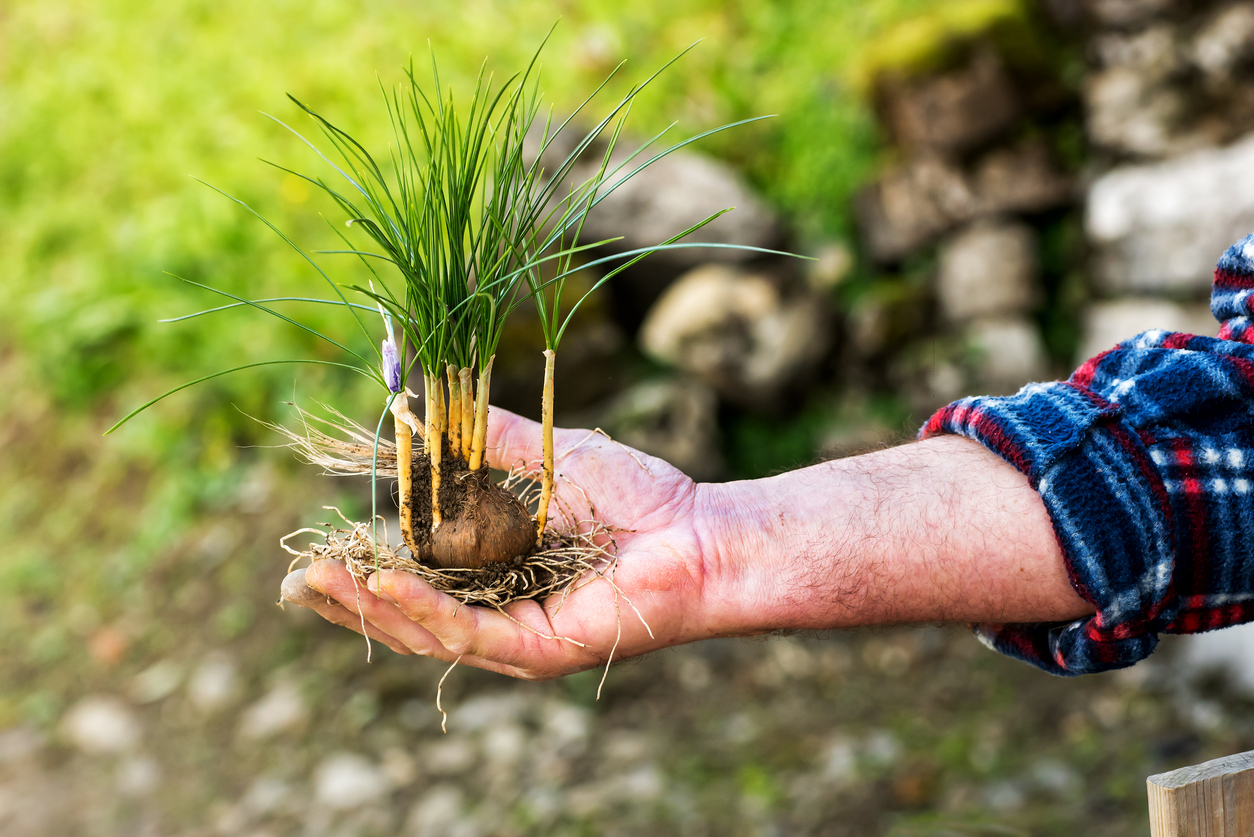
Safety Considerations
Saffron is grown for its highly desirable spice, which is harvested from the flower’s bright-red stigmas. The other parts of the plant are nontoxic, though not considered edible. It is critical that you are 100 percent certain that the stigmas you harvest are from Crocus sativus, so check and save the plant information.
Saffron crocus blooms in the fall and is sometimes called “autumn crocus,” although it is not the same as a highly toxic plant called autumn crocus, meadow saffron, or naked ladies. This similar bulb is Colchicum autumnale, and all parts of the plant are poisonous and can cause death if consumed.
Potential Pests and Diseases
Although saffron crocus produces one of the most expensive spices in the world, it’s a surprisingly low-maintenance plant in the garden. The biggest issue with saffron crocus is usually caused by overwatering from excessive rain or overzealous gardeners. The saffron crocus does not like wet soil and is prone to root rot or fungal diseases. The other potential pest problem is rodents such as squirrels, mice, and voles, who like to make a tasty meal of the corms of the plant.
Harvesting Saffron
Harvesting saffron is a delicate job and a lesson in timing, patience, and precision since the plant can be harvested only while in bloom. The bright-red stigma at the center of the plant is the spice saffron. Pluck them carefully; sterile tweezers are the best tool for the job. Use them right away or dry the stigmas and store them in an airtight container.
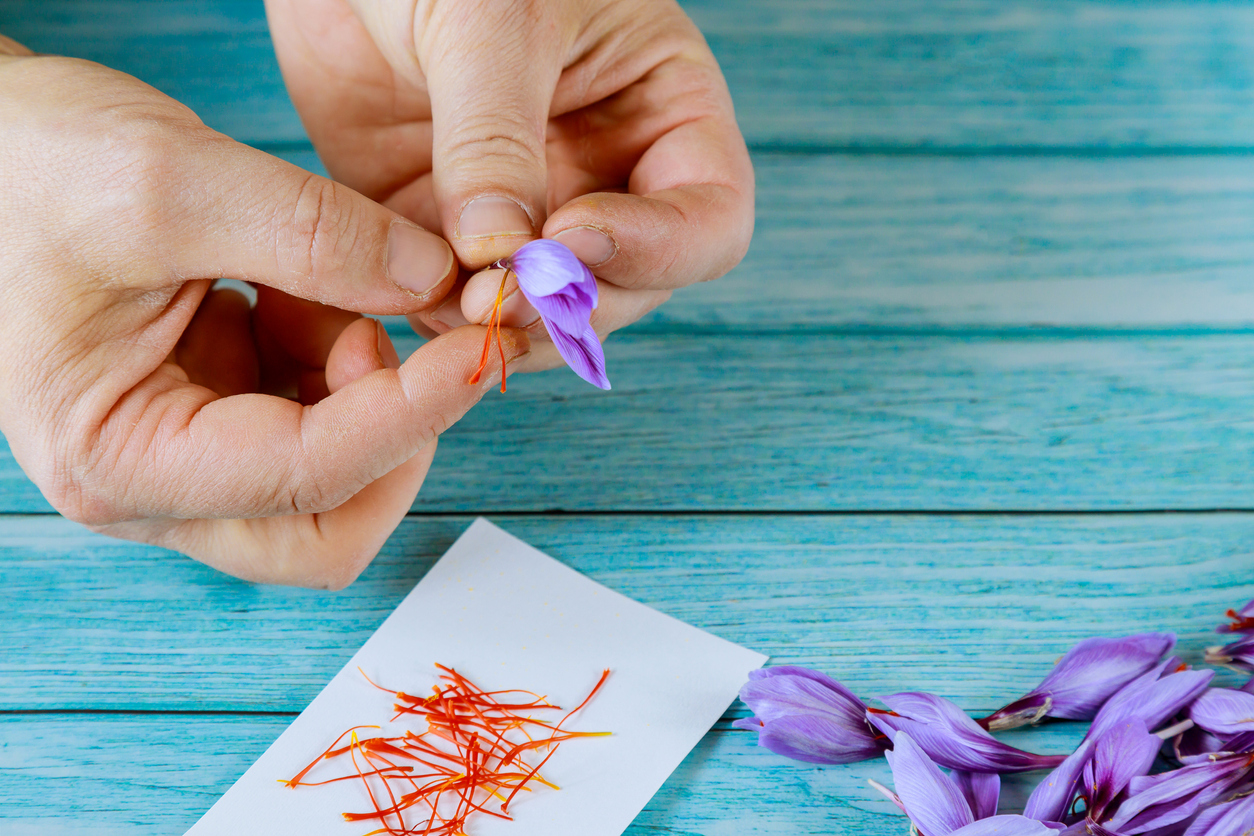
When is the best time to harvest saffron?
Saffron stigmas are harvested when the saffron crocus is in bloom, which is about a 3-week period in the fall, typically from September to November, depending on the climate. The stigmas should be harvested from the flowers shortly after they bloom.
How do you harvest saffron?
Each flower produces only three stigmas, which should be removed carefully by hand. While some growers will pick the entire flower and harvest the stigmas before the flowers become too wilted, the home gardener can harvest the stigmas directly from the plant, leaving the rest of the flower until it fades. According to the University of Florida Institute of Food and Agricultural Sciences, the best time to pick the stigmas is just after the flower opens, which will likely be midmorning when the flowers are open. Ideally, the flowers are dry when picking.
- Gently pluck the bright-red stigmas from the center of the flower.
- Place them on waxed or parchment paper and allow them to air-dry. Stigmas should not overlap when placed on the paper; this allows for even drying.
- Once dried, place the stigmas in an airtight container. Drying time varies but is usually at least 1 to 3 days.
There are many methods for drying herbs, including using the oven at a low temperature, such as 180 degrees Fahrenheit or less for an extended period of time. This method is usually reserved for herbs that have higher moisture content, though, so if you choose to try this method, be careful not to burn the delicate stigmas. Check them frequently.
How do you store saffron?
Keep saffron stored in an airtight container, away from sources of light or moisture. A spice jar or tin works great. Keep your jar in the spice rack at home and use it to flavor any dish that calls for this culinary herb.
Looking for more herbs and spices to grow at home? Check out our guides on growing lemongrass, basil, and cilantro.
